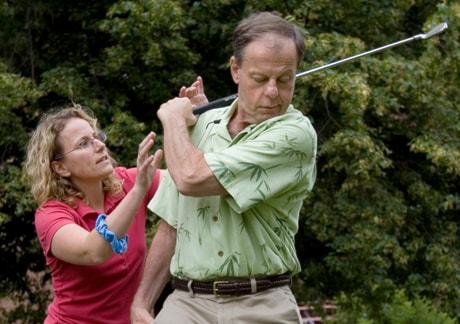TORONTO — In one swift movement, Ray Hooker unleashes a backswing that sends a little white ball soaring — using just one arm.
It’s a remarkable feat in its own right. Not too long ago, it seemed a virtual impossibility.
In 2008, Hooker suffered a massive stroke that resulted in extensive paralysis to the right side of his body.
When occupational therapist Elaine Chan met Hooker last fall, he was in a wheelchair. Less than a year later, the 63-year-old is now able to walk with a cane and stand without assistance.
What’s more, he’s returned to the links, back at the game he’s been playing regularly since he was 50. But in Hooker’s case, golf has become much more than recreation. A unique partnership between health-care professionals is integrating core elements of the game with rehabilitation and physical therapies. A customized program is helping him get back into the swing of things on and off the fairway.
Hooker’s therapists at Toronto’s St. John’s Rehab Hospital have partnered with a London, Ont.-based physiotherapist who pioneered a program that uses golf as a rehabilitation tool.
Sari Shatil is founder of Therapeutic Golf Rehabilitation, which uses the game to help individuals improve steadiness, balance and flexibility in addition to strength and fitness. Exercise and manual therapy techniques also help people better perform the movements that golf requires.
Shatil said the idea behind the golf rehab concept first came to her following her work with patients while at St. Michael’s Hospital in Toronto.
“People were coming out of brain surgery or coming out with paralysis and injuries and they were saying to me, the physiotherapist: ‘I don’t care if I ever walk again, but get me to the golf course,”’ she recalled.
“Then I started thinking: ‘What do we do in therapy?’ We try to encourage people who’ve had strokes to use both sides. We work on balance by weight transfer. We strive for rotational components of movement. And all of these components that we would naturally do in rehab to achieve goals of walking are part of swinging a golf club.”
Intensive sessions at St. John’s Rehab with Elaine Chan and physiotherapist Araceli Landaburu helped Hooker regain his mobility. Strengthening exercises, stepping and balance activities were part of the rehabilitation and recovery process.
In March, Chan first started exploring incorporating golf into Hooker’s therapy — albeit in virtual form — through playing the game on Wii.
By the time he was ready to play Wii golf, Chan said Hooker had adequate standing balance and tolerance that she felt would allow him to hit the ball around outside, which they would try a month later.
“He got really excited,” Chan recalled. “At that point his goals, which initially were just being able to stand and walk because he wasn’t even able to stand unsupported when he came down to us, changed from that to . . . going back onto the golf course.”
Landaburu had previously worked with fellow physiotherapist Shatil and recalled that she had developed an expertise in therapeutic golf. With Hooker’s desire to get back on the green and his enthusiasm for the game, Shatil was brought on board, allowing his therapists to consult her for advice connected to helping his golf skills.
During a recent visit to St. John’s Rehab, Shatil was helping Hooker work on the goal of improving his distance in his golf game which, in turn, could help further strengthen the core skills needed for everyday mobility.
Part of the session involved monitoring the symmetry of his stance to ensure he was equally distributing weight throughout his body, and challenging his weaker or affected side.
The pair also worked on Hooker’s control of the club on the top of the backswing, ran through drills to test his speed and balance, and worked on hip turns to help give distance to the ball through his golf swing.
Hooker said having the ability to put the skills into practice beyond hospital walls makes a big difference.
“Everything you do in the hospital is a very controlled situation, but as soon as you hit the outdoors you are susceptible to the environment so your balance, your overall performance, everything to do with outside improves dramatically,” he said.
